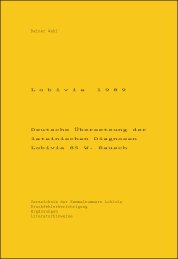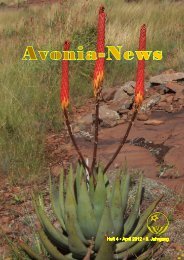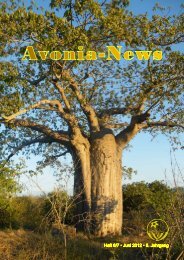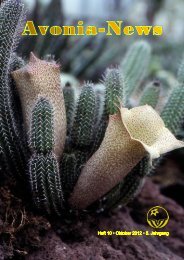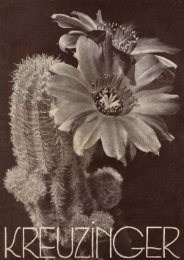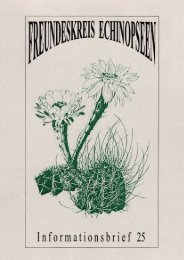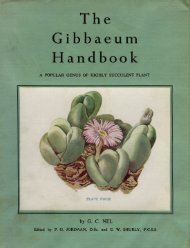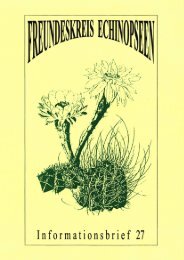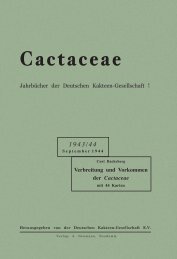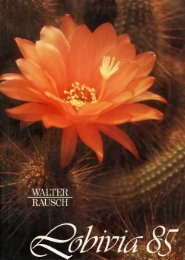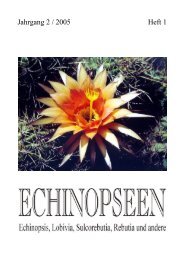Lithops - Au Cactus Francophone
Lithops - Au Cactus Francophone
Lithops - Au Cactus Francophone
You also want an ePaper? Increase the reach of your titles
YUMPU automatically turns print PDFs into web optimized ePapers that Google loves.
tirely different to those where the plant normally grows (Prieska, Britstown,<br />
Kraankuil). One of two explanations is possible: (i) If it does really grow in<br />
the Klinghardt Mts., then it is the only ease, where a species of this genus<br />
has so to say jumped hundreds of miles, and that is something quite unu<br />
sual in this genus; (ii) the more plausible one is that W. Triebner must have<br />
made a mistake in the habitat of the plant he is supposed to have sent to<br />
the University of Stellenbosch. I am strengthened in this latter view by the<br />
fact that Herr Eberlanz, Lüderitzbucht, who knows that part of the country<br />
very well, wrote to me as follows: „Ich kenne den Fundort von L. aurantiaca<br />
nicht, glaube aber nicht, dass diese Art aus dem Klinghardtgebirge stammt.<br />
Nach Professor Dinter, welcher 1923 dort sammelte, ist wohl kein Sammler<br />
dort gewesen. Da die Consolidated Diamond Co., dieses Gebiet hermetisch<br />
ver schlossen hielt, besteht keine Möglichkeit dorthin zu gelangen.’’<br />
It appears that the plant No. 9180, which is time type, was sent by<br />
Max Schlechter, Port Nolloth, to Pastor Meyer. Steinkopf, who passed it on<br />
the University of Stellenbosch. That W. Triebner collected it seems to he a<br />
mistake. From the above it is quite clear that L. aurantiaca L. Bol. is identical<br />
with L. turbiniformis.<br />
<strong>Lithops</strong> turbiniformis. (Plate 38, 38a, Fig. 104.) Plante vorm klompe van 1,<br />
2 en meer; boonste top vlak, ondeursigtig, met baie rimpels, die rimpels van<br />
’n roesbruin tot ’n geelbruin kleur, die duike self effens donkerder gekleurd;<br />
some afwesig; bloom geel.<br />
152<br />
Prieska; Britstown; Strydenburg; Kraammkuil.<br />
Tussen L. aurantiaca L. Bol. en L. turbiniformis is daar m.i. geen verskil<br />
nie en daarom het ek eersgenoemde opgeneem in laasgenoemde. L. aurantiaca<br />
is deur Triebner in 1930 aan die Botaniese tuin, Universiteit, Stellenbosch<br />
gestuur. Dit het toe in April 1932 geblom en is toe deur L. Bolus beskrywe.<br />
In haar beskrywing beweer sy „crebre impressa rugosaque fere in more L.<br />
turbiniformis”, maar ongelukkig sê sy nie in watter spesifieke opsig of opsigte<br />
hierdie twee soorte veronderstel is om van mekaar te verskil nie. Die oor<br />
spronklike plante waarvan die beskrywing van L. aurantiaca gemaak is, was<br />
toe geskilder onder die indruk dat L. aurantiaca ’n aparte soort is. Plaat 38<br />
is die een waarna verwys word. Toe die vraag egter opkom om ’n sleutel vir<br />
die soorte te maak, was dit onmoontlik om enige verskil tussen L. turbini‑<br />
formis en L. aurantiaca te vind waardeur laasgenoemde as ’n soort kon behou<br />
word.<br />
Dit is waar dat as ’n mens die portret van L. turbiniformis vat in Gard.<br />
Chron. Feb. 4, 1922, p. 55, Fig. 28, verskyn nader ondersoek, clan is dit duide<br />
lik dat die rimpels baie prominent en duidelik is. My eie ondervinding, egter,<br />
van hierdie soort beide in die veld en in die broeikas is dat ’n mens nie te<br />
veel waarde kan heg nie aan die graad van gerimpeldheid. Die blare vernaam



